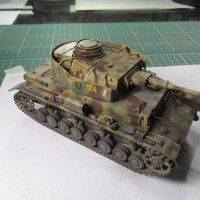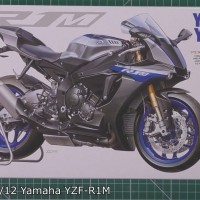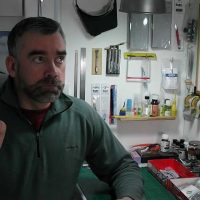Airfix F-86F-40 modified to Sabre Mk. 6 and the Golden Hawks for F-86 Sabre Group Build
The Airplane:
The Canadair Sabre series was built by Canadair under licence from North American Aviation. Sabres were produced until 1958 and used primarily by the Royal Canadian Air Force (RCAF) until replaced with the Canadair CF-104 in 1962. Several other air forces also operated the aircraft.
In 1948, the Canadian government decided to re-equip the RCAF with the F-86 Sabre under license. The sole Sabre Mk.1 was essentially the same as the North American Sabre F-86A. An initial batch of 10 aircraft was ordered for tool verification; these were based on the F-86E-5. The advent of the Korean War changed this to a production batch of 100 aircraft, which were designated Sabre Mk.2, with the Canadair project number CL-13. After the first 20 were produced, the rest of the Mk. 2 production run was equipped with power-assisted controls and an "all-flying" tailplane.
The majority of the Mk. 2 production was sent to the USAF to make up a shortage of Sabres caused by the Korean War, which were known in US service as the
The single Mk. 3 was the test-bed for fitting the more powerful Avro Canada Orenda engine. Jacqueline Cochran used this airplane in 1953 to set several speed records, including becoming the first woman to break the sound barrier. This airplane used the Orenda 3 with 6,000 lbf thrust.
In 1952, the Sabre Mk. 4, which was the F-86E-15 went into production. Of 600 prodeuced, 400 were for the RAF, which adopted the airplane while the Hawker Hunter was delayed.
The RCAF Sabre Mk.2s were refurbished when they left service and given to the Turkish and Yugoslavian air forces. When the Mk.4 left RAF service in 1956 due to the arrival of the Hunter, these aircrft were refurbished by Canadair and returned to the USAF, which had funded them through the MDAP program. These Sabres were fitted with the “6-3" wing extension and provided to the Italian and Greek air forces.
Although replaced by higher-performance designs in most other forces by the 1960s, late-model Sabre Mk. 6 versions served in secondary roles into the 1970s.
On 30 July 1953, the first Sabre Mk.5 flew with the Orenda 10 engine with 6,500 lbs thust, giving it an improvement in rate of climb and ceiling over earlier variants. The Mk 5 adopted the US improvements for the F-86F, including the 6.3 wing with the leading edge slats removed. This modification dramatically improved maneuverability, though the loss of the slatted leading edge increased landing speed and degraded low speed handling considerably. Canadair built 370 Mk 5s, the majority of which saw service with the RCAF's Air Division squadrons in Europe to replace the Mk.2s. A total of 75 RCAF Sabre 5s were transferred to the West German Bundesluftwaffe during 1957.
This was followed by the the Sabre Mk.6., considered to be the best production Sabre ever built. It was equipped with a two-stage Orenda 14 engine developing 7,275 pounds of static thrust. Its altitude performance and climb rate was enhanced over the Mk 5 and the reinstatement of the wing leading edge slats gave it excellent low-speed characteristics. The first production model was completed on 2 November 1954; 655 were built with production terminating on 9 October 1958.
A total of 390 Mk.6s went to the RCAF with the majority replacing the existing Canadair Sabre Mk.5s at the Air Division squadrons in West Germany and France.
In addition to the RCAF deliveries, 225 Canadair Mk.6 Sabres were exported to the West German Luftwaffe, six were delivered to the Colombian Air Force, and 34 went to the South African Air Force.
The Golden Hawks Flight Demonstration Team:
The Golden Hawks Flight Demonstration Team was established in 1959 to celebrate the Royal Canadian Air Force's 35th anniversary and the "Golden" 50th anniversary of Canadian flight in 1909.
Initially, a six-plane team flying metallic-gold Sabre Mk.5s was only to perform for one year, but the Golden Hawks were so popular after the 63-show season that the team was expanded. In 1960, another Sabre was added to the team, which provided a five-plane main formation with two solo jets. The Golden Hawks changed to the Sabre Mk 6 in 1961, which they flew until the team was disbanded, ostensibly for financial reasons, on February 7, 1964, having flown a total of 317 shows across North America.
The team performed standard loops and rolls in very tight formation, and introduced their own trademark maneuvers, including a two-aircraft head-on solo program which was adopted by nearly every military team in the years since the Canadians introduced it. They also invented the Card 5 Maneuver, where five aircraft fly in a card formation, two up front, one in the middle, two in the back, and the Coordinated Two Aircraft 360, where two aircraft fly in opposite directions at low level in a horizontal circle and pass each other on both sides of the circle.
Today, a restored Sabre Mk 5 called “Haw One” performs at Canadian air shows.
The kit:
The Airfix F-86F-40 Sabre appeared in 2022. It has been panned by many reviewers for being a product of the Airfix “bean counters”, not up to the quality and detail standards of “new” Airfix. The one thing it has going for it is the fact it has deployable leading slats.
Since this Sabre has a 6-3 wing and slats, it is the kit most amenable to modification to Sabre Mk 6 configuration.
Construction:
When I found the Airfix kit at the LHS,the lightbulb came on over my head, that I had the Leading Edge Golden Hawks decals, that modifying the “long” dash-40 wing wasn't that hard, and that I now possessed a good gold paint, Super Gold from the Mr Mobby Super Metallics series. I bought the kit and when I got home I proceeded to modify it.
The main thing is the wingspan. Fortunately, that additional span is contained in an add-on section. It's easy to cut off the wingtip, then cut the extension off at the next-inboard panel line. The wingtip has to be enlarged to fit the new wing position, but that's not hard. I used a piece of sprue and sanded it to shape once glued to the divided pieces of the wingtip.
I then proceeded to build the kit according to the instructions. Since I didn't have an aftermarket seat, and the Airfix cockpit isn't really right, I decided to close the canopy, which preserves the airplane's lines. With the cockpit painted black and the canopy closed, all that can be seen is the seat, which is “good enough.” During assenmbly of the fuselage, I glued in sufficient fishweights to insure nose-sitting. I made “sugar scoops” from some Evergreen stock, and closed up the area right ahead of the dorsal fin, sanding it smooth, since the Mk 5 and Mk 6 Canadair Sabres don't have that.
Painting:
I painted the leading edge of the wing and the slats with Tamiya LP-11 Silver, which is Tamiya AS-12 silver in a bottle instead of a spray can. The main benefit for this project is it can be masked over without any fear of lift-off later, I airbrushed the wing leading edge and the that of the vertical fin and stabilizers. After it was allowed to set up overnight, applying drafting tape to the proper areas was no problem.
I first pained the anti-glare area on the nose with Tamiya X-18 “Semi Gloss Black,” then masked that off nd painted the rest of the model with Mr Hobby Superfine Metallics SM202 “Super Gold 2.” This was thinned 50-50 with Mr Color Leveling Thinner 400, and misted on. After allowing it to dry overnight, I gave the whole model a coat of clear gloss to protect the paint when I applied the decals.
Decals:
The decals were a bit thick, but they went down with repeated applications of Micro-Sol.
Final Assembly:
I unmasked the canopy, the attached the nose plug which I painted red. I then attached the landing gear and drop tanks and called it done.
If course, after that, a Canadian friend at the local model club told me when I displayed the model that the Golden Hawks had locked the leading edge slats closed, the same way the Blue Angels closed the slats on the Skyhawk when they flew that airplane. When I said I had a photo of a Golden Hawk with the slats deployed, I learned that is “Hawk One,” the memorial demonstrator. Oh well. Now I can tell you that the kit to use to do this if you want to is the Hasegawa F-86F-30, but be sure to close that intake on the right side by the dive bakes, since Sabre 6s don't have it.
Overall:
I'm not too concerned about the “mistake” with the slats, since there is only one person in Los Angeles likely to see the model who knows the mistake and he already told me. Hey, it's a gold Sabre and it looks good sitting with the others.
















Nice work on this Tom ,interesting colour as well, amazing what can be achieved from a store bought kit. I have this one in the stash.
I laughed out loud, Neil. Shall we go put our "clown makeup" on for the day's performance? 🙂
Interesting history and neat conversion, Tom.
Now that’s a posh looking Sabre in gold, Tom!
Nice conversion too. Great job. 👍
Great post Tom, kit looks very nice. Your scheme has got to be my favourite Sabre scheme, love the gold finish. The Leafing Edge decals do feel thick at first, but they do apply so well.
Just a note about GH Sabre 23651, it’s on display in Hamilton’s CWHM.
In 2020, it was on display with the leading edge flaps deployed on the port side.
Talking to a tour guide, he pushed the leading flaps back and forth by hand to show the different positions.
2 attached images. Click to enlarge.
So this is a model of the airplane as it is in a museum. Thanks! That's my story now, and I'm stickin' to it 🙂
That turned out super attractive! Well done, Tom.
Excellent model, striking scheme and most informative article, Tom!
Well done Sabre. The Golden Hawks scheme stands out...
I like it Tom (@tcinla). The golden color really accentuates an already attractive design. The Sabre, is, like the Mustang, one of those aircraft that just "look right" and I never tire of seeing examples of it. Great work on this and thanks for sharing.
Beautiful Sabre. The gold color is a real knockout and so is your thorough article, Tom @tcinla.
Thanks. The check is in the mail, as they say. 🙂
Very interesting article and a ditto scheme, Tom @tcinla
The Sabre does look great in gold. An absolutely great result.
Very beautiful build with a sleek scheme, that fits the elegant shape of the Sabre perfectly, Tom @tcinla. People seem to dislike the Airfix kit, i enjoyed it apart from a somewhat empty cockpit.
Very nice and interesting history. I remember seeing the Golden Hawks back in the early '60s.
Lucky you! I have seen the Snowbirds whenever possible. Can't wait for the Lucky Model Tutor to come out.
Your gold Sabre really looks great, Tom (@tcinla). It was a pleasure following along in the group build.
A cool scheme for the Sabre, and a well-built model. Nicely done!
Very nice work and wonderful coloring.